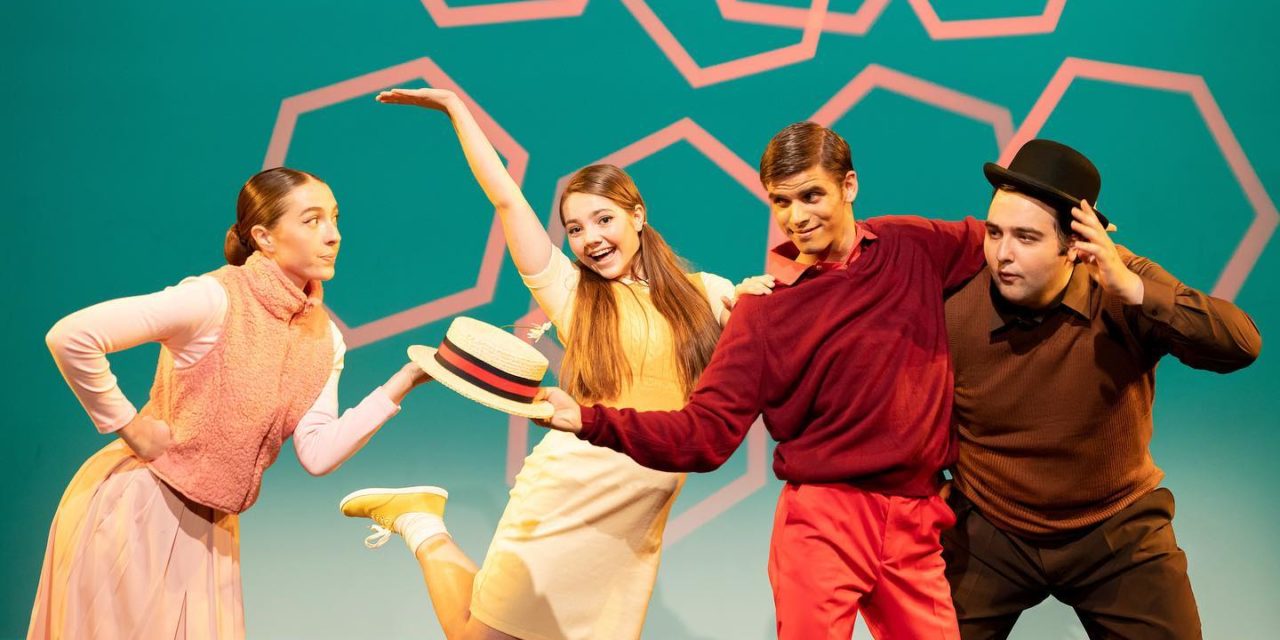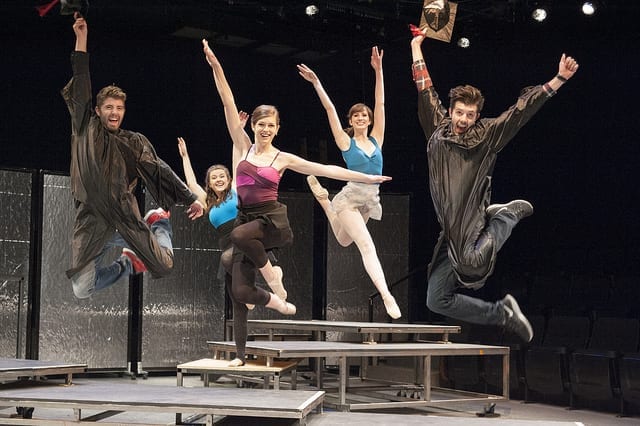PROVO — When was the last time you were truly curious about something? Comedians, scholars, and pundits have decried the end of curiosity owing to the accessibility of information from sources like Google, Siri and Alexa. However, Eleanor Roosevelt described children as, “living question marks,” and has given entire discourses in defense of curiosity. It is a power that enables someone to be entranced by something simple until it is understood and then continue wondering about it as if it’s the most valuable treasure on earth—even just for that moment. Director Teresa Love captures the essence of making audience members curious and with a stellar student cast maintains that intrigue for a full hour in the BYU Young Company production of Go Dog Go, adapted from the P.D. Eastman book of the same title by Steven Dietz, Allison Gregory, and Michael Koerner.
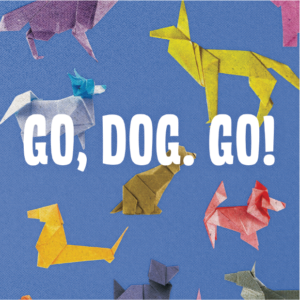
Show closes November 19, 2022.
If you’re familiar with the Eastman book, you might wonder how on earth an hour-long play could come from a book that is both simplistic and at times repetitive. If you’re curious enough to find out, I believe you’ll be rewarded. My last review decried a theatre for young audiences (TYA) production for having a weak and formulaic script that held no stakes whatsoever and led to an underwhelming production. The experience of this BYU Young Company show couldn’t be further from that. It was a child and adult friendly experience from walking into the venue until well after the show was over.
Upon arrival, you’ll find tables filled with origami craft paper and Go Dog Go cast members dressed in colorful vintage costumes with sweaters, bobby socks, and character-distinctive hats. Each cast member greets and welcomes audience members inviting them to learn to make origami dogs that they can take into the show. From there, young children were invited to sit on the floor near the stage for a better view and to be invited up at certain points to participate in stage. Because the Young Company productions tour, the set was simple. There were a few collapsible canvas trees, assorted toys and artifacts from by gone eras, and a narrow metallic bench, which was the origin point for Matthew McComb’s MC Dog (the brown one). For several minutes as the play began, he sat and fiddled with various things, including his hat, while making comprehensible but indistinguishable sounds. This non-verbal character work was gripping in the same way Chaplin, Keaton, Depp and others have done so masterfully. Eventually, he procured an origami brown paper dog that he bore a striking resemblance to himself. He then introduced the other actors by procuring similar figurines for the other colors of dogs.
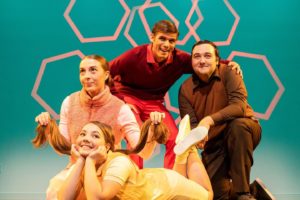 The story follows a series of vignettes with the dogs engaging in things that readers may be familiar with from the Eastman text. Dogs hitting baseballs (play dogs play!) and dogs using tools (work dogs work!). In delightfully creative ways, props are used to show the dogs riding carnival rides, driving cars, sleeping, dreaming, and getting into trouble, all the while consistently and patiently engaging adults and children from the audience into the performance. The involvement flowed naturally as the show would continue while an actor or two would slip away from the main focus to invite people to come join them on stage. Children joined conga lines or pantomimed playing baseball while adults created oceans or wandered “in” and “out” of various imagined locations. It was incredible to watch so many people unafraid to get up and play without much context or explicit instruction to audience members. It was an immersive experience that had me laughing, cheering and smiling from beginning to end.
The story follows a series of vignettes with the dogs engaging in things that readers may be familiar with from the Eastman text. Dogs hitting baseballs (play dogs play!) and dogs using tools (work dogs work!). In delightfully creative ways, props are used to show the dogs riding carnival rides, driving cars, sleeping, dreaming, and getting into trouble, all the while consistently and patiently engaging adults and children from the audience into the performance. The involvement flowed naturally as the show would continue while an actor or two would slip away from the main focus to invite people to come join them on stage. Children joined conga lines or pantomimed playing baseball while adults created oceans or wandered “in” and “out” of various imagined locations. It was incredible to watch so many people unafraid to get up and play without much context or explicit instruction to audience members. It was an immersive experience that had me laughing, cheering and smiling from beginning to end.
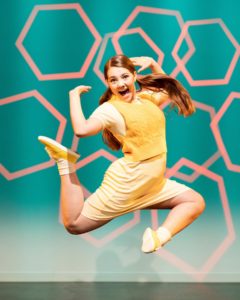 In an almost imperceptible way, McComb and his fellow actors were able to ease the audience into understanding the unspoken language of the production and the audience’s relationship to the actors. This understanding was carried through by the strong ensemble that each had moments of imaginative play that sparked curiosity of what these dogs might do next. Laura Jacobs’ portrayal of the little yellow dog who consistently was left out was endearing. Her ability to convey with crystal clear intensity her dog’s emotions and intentions was worthy of Stanislavski. At one point, the Blue Dog, portrayed by Dalton Knight, was alone on stage and summarized and caricatured the whole show up to that point in just a minute or two with simple language and precise gestures and movement. Each of the dogs found ways to make their characters distinct and interesting simply by aggressively pursuing character traits and objectives with intensity of focus and wonderful silliness of play. But for spacing, I could easily sing the praises of each actor who made the show dynamic by playing simple contrasts to one another.
In an almost imperceptible way, McComb and his fellow actors were able to ease the audience into understanding the unspoken language of the production and the audience’s relationship to the actors. This understanding was carried through by the strong ensemble that each had moments of imaginative play that sparked curiosity of what these dogs might do next. Laura Jacobs’ portrayal of the little yellow dog who consistently was left out was endearing. Her ability to convey with crystal clear intensity her dog’s emotions and intentions was worthy of Stanislavski. At one point, the Blue Dog, portrayed by Dalton Knight, was alone on stage and summarized and caricatured the whole show up to that point in just a minute or two with simple language and precise gestures and movement. Each of the dogs found ways to make their characters distinct and interesting simply by aggressively pursuing character traits and objectives with intensity of focus and wonderful silliness of play. But for spacing, I could easily sing the praises of each actor who made the show dynamic by playing simple contrasts to one another.
 The late Mark Brotherton, a professor in my graduate theatre program, would often say, “It’s called a play, not a serious.” This was a hall of fame worthy production of just that. Go Dog Go is not an easy script to pull off. Most of the story is told through gesture and onomatopoeia interspersed with the simplistic text of a low Lexile children’s book. However, it takes intense creative play for a director and cast to make such a thing not only fun, but also gripping. I brought three of my four children, the youngest being two, to attend, and despite our dozens of readings of the book, I watched them laser focus on the story as if they desperately needed to know what would happen to the red dog in the blue tree, the blue dog in the red tree, or the green dog in the yellow tree. Spoilers, the yellow dog doesn’t find a green tree.
The late Mark Brotherton, a professor in my graduate theatre program, would often say, “It’s called a play, not a serious.” This was a hall of fame worthy production of just that. Go Dog Go is not an easy script to pull off. Most of the story is told through gesture and onomatopoeia interspersed with the simplistic text of a low Lexile children’s book. However, it takes intense creative play for a director and cast to make such a thing not only fun, but also gripping. I brought three of my four children, the youngest being two, to attend, and despite our dozens of readings of the book, I watched them laser focus on the story as if they desperately needed to know what would happen to the red dog in the blue tree, the blue dog in the red tree, or the green dog in the yellow tree. Spoilers, the yellow dog doesn’t find a green tree.
Even as I write this, I know that it seems like it may not be everyone’s cup of tea, or hot cocoa since it’s at BYU. No thank you, I’d rather sit in my chosen seat, hear, “Do You Hear the People Sing,” and leave having been touched without being, well, touched. However, this excellent production of Go Dog Go snared my curiosity from the moment I wondered how to make an Origami Dog to the show’s exciting climax when I wondered if the brown dog would ever like the pink dog’s hat. At the show’s end, actors signed autographs for children, let them play with props they’d watched all show, and were able to walk out with ribbons of confetti blasted during the great dog party.
This is what TYA is about. My children learned how to make origami dogs and to sit patiently in wonder. They read people’s thoughts and expressions, including my two year old who made insightful comments and asked people to move loudly so he could see. Another child shouted, “wait, there’s no tree up there! That’s just lights,” about 45 minutes into the show; and the actors and audience welcomed it. The play wasn’t pretending to be something it wasn’t. In a way that Bertolt Brecht would have been proud of, there was no question at any time that this was a performance; but it was a performance that invited all to sit, to play, to laugh and to be curious about something simple. If I’ve piqued your curiosity, then run, reader, run, to see Go Dog Go at BYU.

